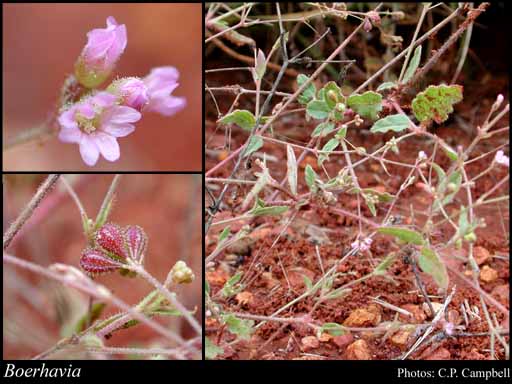- Reference
- Sp.Pl. [Linnaeus] 2:3 (1753)
- Name Status
- Current







Scientific Description
Common name. Tarvines. Family Nyctaginaceae.
Habit and leaf form. Herbs. Annual, or perennial. Leaves cauline. Young stems cylindrical. Stem internodes solid. Mesophytic. Leaves opposite; petiolate, or sessile; simple. Leaf blades entire; pinnately veined; cross-venulate. Leaves without stipules. Leaf blade margins entire (undulate or sinuate). Leaf anatomy. Hairs present, or absent; glandular hairs present (commonly glandular viscid, 3 main types of hairs important in determining species). Extra-floral nectaries absent. Stem anatomy. Secondary thickening anomalous; via concentric cambia.
Reproductive type, pollination. Fertile flowers hermaphrodite. Unisexual flowers absent. Plants hermaphrodite.
Inflorescence and flower features. Flowers small, solitary, or aggregated in ‘inflorescences’; in cymes (L), or in umbels (AK), or in glomerules (AK). The terminal inflorescence unit cymose. Inflorescences axillary; inflorescences usually grading along branches from simple to compound; with involucral bracts, or without involucral bracts; pseudanthial, or not pseudanthial. Flowers pedicellate, or sessile; bracteate (small, caducous). Bracts deciduous. Flowers bracteolate (minute, membranous, caducous). Bracteoles deciduous. Flowers small, or medium-sized; regular; cyclic; tricyclic. Free hypanthium absent. Perianth sepaline; 5; 1 -whorled; joined. Calyx present; 5; 1 -whorled; gamosepalous; blunt-lobed (these truncate); valvate, or plicate in bud; campanulate, or funnel-shaped (or trumpet shaped); regular; white, or pink, or purple to blue (mauve or crimson-purple); base persistent. Corolla absent. Androecial members definite in number. Androecium 1–6. Androecial sequence determinable, or not determinable. Androecial members adnate (to the perianth tube), or free of the perianth; all equal; free of one another; 1 -whorled. Androecium exclusively of fertile stamens. Stamens 1–4(–6); all more or less similar in shape; hypogonous; inflexed in bud. Anthers dehiscing via longitudinal slits; introrse; tetrasporangiate. Gynoecium 1 carpelled. The pistil 1 celled. Carpels reduced in number relative to the perianth. Gynoecium monomerous; of one carpel; superior. Carpel stylate; apically stigmatic; 1 ovuled. Placentation basal. Ovary shortly stipitate. Ovules ascending; non-arillate; campylotropous, or hemianatropous.
Fruit and seed features. Fruit non-fleshy. The fruiting carpel indehiscent; an achene, or nucular. Fruit 1 celled; 1 seeded. Seeds endospermic, or non-endospermic. Perisperm present. Embryo well differentiated (large). Cotyledons 2. Embryo curved, or straight, or bent.
Etymology. After Hermann Boerhaave (1668–1738), Dutch physician, rector of the University of Leiden, professor of medicine, botany and chemistry; in his day one of the leading botanists of Europe.
Taxonomic Literature
- Wheeler, J. R.; Rye, B. L.; Koch, B. L.; Wilson, A. J. G.; Western Australian Herbarium 1992. Flora of the Kimberley region. Western Australian Herbarium.. Como, W.A..
- Blackall, William E.; Grieve, Brian J. 1988. How to know Western Australian wildflowers : a key to the flora of the extratropical regions of Western Australia. Part I : Dicotyledons (Casuarinaceae to Chenopodiaceae). University of W.A. Press.. [Perth]..
- Australia. Bureau of Flora and Fauna 1984. Flora of Australia. Volume 4, Phytolaccaceae to Chenopodiaceae. Australian Govt. Pub. Service.. Canberra..